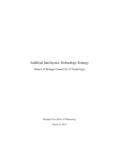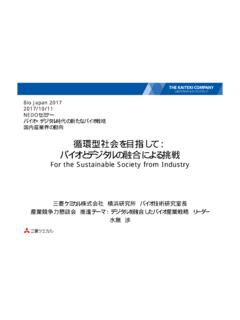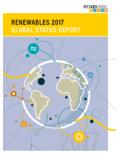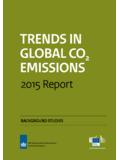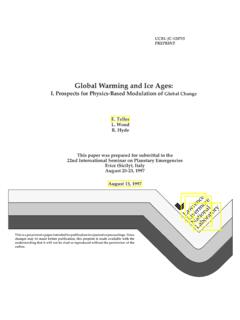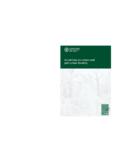Transcription of NEDO offshore wind energy progress EditionⅡ
1 NEDO offshorewind energyprogress EditionIINew energy and Industrial Technology Development OrganizationOffshore Wind Condition Observation System Proving ResearchOffshore Wind Power Generation System Proving ResearchMega-Size Wind Power Development System Technology Research and Development2 Step-up gearPower generatorNacelleThe container facility designed to store bearings, step-up gears, power generators and other components. Mounting with salt removal equipment and other features gives this unit greater effectiveness in salt-damage countermeasures than onshore GeneratingSystem Step-up gear: System that raises blade rotations (by over a dozen round per minute) to 1,500~1,800 round per minute, for transmission to the power generator.
2 Power generators: Induction generators simple in structure and low in cost and synchronous generators offering adjustments in voltage and other parameters, other types. Surveillance equipment: Use of remote surveillance systems to monitor offshore wind turbine operating status, structural fatigue and other conditions on real-time basis, exercising efficient rNacellePower generator Foundation Structural portion used to support the subsurface tower. Gravity type: Foundation structure suitable when the ocean floor base is in a relatively favorable location. Interior is hollow, with slag serving as a weight injected to help stabilize.
3 ( offshore Choshi) Hybrid gravity type: Resistant to impact from the base, designed by adopting the advantages of the gravity system and jacket structure system. ( offshore Kitakyushu City)Foundation 3 offshore Wind Power Generation Project Wind power generation involves lower power generation costs than solar, wave or tidal the various forms of renewable energy , wind power also compares favorable in terms of cost competitiveness. Within this genre, compared to onshore power generation, the advantages of offshore wind power include stable and efficient power generation and the ability to evolve to use of large-size wind turbines.
4 As a result, the introduction and use of offshore wind power is rapidly advancing with the focus on Europe. In this issue, we focus in on projects aimed at realizing Japan s very first offshore wind power these undertakings, NEDO is handling the oceangoing installation of offshore wind condition observation towers used to track offshore wind direction and velocity, and the wind turbines to be mobilized to actually generate offshore wind Wind Power Generation Project NEDO Interview Japan First!Rising to the Challenge of offshore Wind Power Generation Amidst Global Competition, National Leadership Needed to Cultivate the offshore Wind Industry Takeshi Ishihara, NEDO Project Leader, Research and Development of offshore Wind Power Generation Technology Project Domestic First!
5 offshore Wind Power Generation to Commence- Started to the Operation of offshore Wind Power Generation System! from Choshi - Started to the Operation of offshore Wind Power Generation System! from KitakyushuTargeting the World Market with 7MW-Class Mega-Size Wind Turbines 4 NEDO Interview In the European Union (EU), there the introduction of wind power generation is being advanced at a greater rate than any other region in the world, member nations are assessed with legally binding numerical targets in the quest to achieve the goal of generating 20% of EU power with renewable energy by the year 2020. Within this trend, in view of high expectations attached to wind power generation, the decline in suitable onshore sites for such projects, interest in securing employment accompanying the fall in production at North Sea oil fields and other perspectives, moves are expanding to shift wind power generation from onshore to offshore locations.
6 Thus far, as of late 2012, 5400 MW of offshore wind power generation has been deployed, primarily in Europe. offshore wind power generation is a promising option in Japan as well for expanding the deployment of wind power generation. NEDO initiated a feasibility study of offshore power generation in FY2008. In FY2009, a demonstration research project was launched with the construction of Japan s first wind condition observation towers and offshore wind turbines for installation in the Pacific Ocean and Japan Sea to monitor the differing meteorological and oceanographic conditions. After repeated typhoons and strong waves, installation of the offshore wind turbine off the coast of Choshi, Chiba Prefecture, in the Pacific Ocean demonstration area was completed in October 2012.
7 Likewise, installation of the offshore wind turbine off the coast of Kitakyushu City, Fukuoka Prefecture, in the Sea of Japan demonstration area was completed in March 2013. While being baptized in these severe natural environments, we were able to successfully guide the construction of Japan s first offshore wind power generators to completion. This success was the result of the efforts of the project team members and the cooperation from the local areas. We would like to take this opportunity to express our heartfelt from Onshore Wind Power Generation to offshore Wind Power GenerationJapan First !
8 Rising to the Challenge ofOffshore Wind Power GenerationWith the key focus on Europe, construction of offshore wind power plants continues to pick up by growing expectations for the role of renewable energy , interest in this sector is rising in Japan as has been advancing efforts in offshore wind power generation since 2009. In this feature, we profile the global trend toward offshore wind power generation, and the positioning of NEDO projects within this Itoh, Senior Researcher, New energy Department,New energy and Industrial Development Organization (NEDO)View from the nacelle of Byobugaura ( offshore Choshi in Chiba Prefecture), widely known as the Straits of Dover of the Orient.
9 5 Among the available types of renewable energy , wind power generation offers the advantages of mature technological systems and a rich track record, as well as lower generation costs. For these reasons, the introduction and popularization of wind power is advancing. In Japan as well, introduction of wind power generation has rapidly increased, primarily involving onshore installation, from the first half of the 2000s decade. At the end of fiscal 2011, total wind power output in Japan stood at approx. GW (1,870 wind turbines). Looking to the future, however, forecasts are for a decline in suitable onshore locations for wind power generation due to wind conditions, restrictions on such sites and other impacting factors.
10 In order to expand the implementation of wind power generation in spite of these conditions, the need exists to advance offshore wind power development a sector believed to hold massive potential. The challenges involved in offshore wind power development may be divided into three key categories. The first is that of cost. Because offshore wind turbines are installed within ocean environments, the cost is said to run roughly twice that of onshore facilities. This includes the wind turbines themselves, the foundations (bases submerged in the waters), submarine cable installation work and other project aspects.


